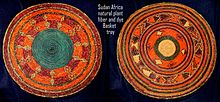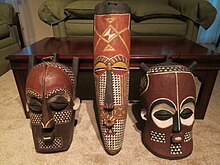Historical overview
Africa is divided into a great number of ethnic cultures.[2][3][4] The continent's cultural regeneration has also been an integral aspect of post-independence nation-building on the continent, with a recognition of the need to harness the cultural resources of Africa to enrich the process of education, requiring the creation of an enabling environment in a number of ways. In recent times, the call for a much greater emphasis on the cultural dimension in all aspects of development has become increasingly vocal.[5] During the Roman colonization of North Africa,(parts of Algeria, Libya, Egypt and the whole of Tunisia) provinces such as Tripolitania became major producers of food for the republic and the empire, this generated much wealth in these places for their 400 years of occupation.[6] During colonialism in Africa, Europeans possessed attitudes of superiority and a sense of mission. The French were able to accept an African as French if that person gave up their African culture and adopted French ways. Knowledge of the Portuguese language and culture and abandonment of traditional African ways defined one as civilized.[7] Kenyan social commentator Mwiti Mugambi argues that the future of Africa can only be forged from accepting and mending the sociocultural present. For Mugambi, colonial cultural hangovers, pervasive Western cultural inundation, and aid-giving arm-twisting donors are, he argues, here to stay and no amount of looking into Africa's past will make them go away. However, Maulana Karenga states:
African arts and crafts
Main article: African art
Africa has a rich tradition of arts and crafts. African arts and crafts find expression in a variety of woodcarvings, brass and leather art works. African arts and crafts also include sculpture, paintings, pottery, ceremonial and religious headgear and dress.Maulana Karenga states that in African art, the object was not as important as the soul force behind the creation of the object. He also states that All art must be revolutionary and in being revolutionary it must be collective, committing, and functional.[citation needed]
Certain African cultures has always placed emphasis on personal appearance andjewelry has remained an important personalaccessory. Many pieces of such jewelry are made ofcowry shells and similar materials. Similarly, masks are made with elaborate designs and are an important part of some cultures in Africa. Masks are used in various ceremonies depicting ancestors and spirits, mythological characters and deities.
In many traditional arts and craft traditions in Africa, certain themes significant to those particular cultures recur, including a couple, a woman with a child, a male with a weapon or animal, and an outsider or a stranger. Couples may represent ancestors, community founder, married couple or twins. The couple theme rarely exhibit intimacy of men and women. The mother with the child or children reveals intense desire of the women to have children. The theme is also representative of mother mars and the people as her children. The man with the weapon or animal theme symbolizes honor and power. A stranger may be from some other tribe or someone from a different country, and more distorted portrayal of the stranger indicates proportionately greater gap from the stranger.IT WILL BE CONTINUER














No comments:
Post a Comment